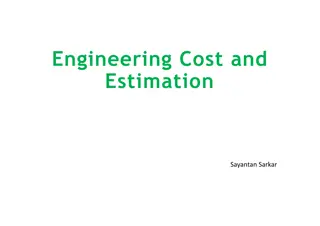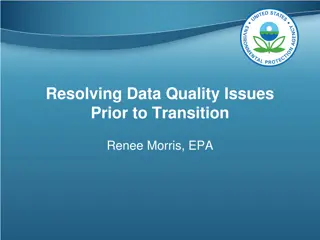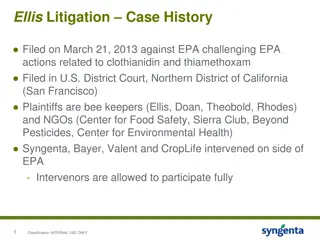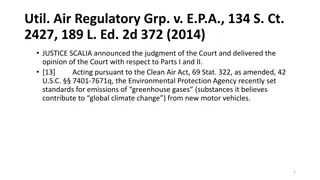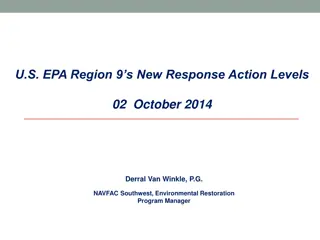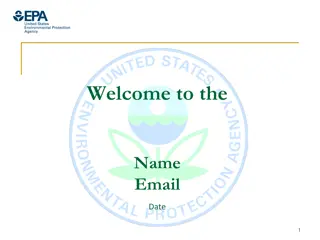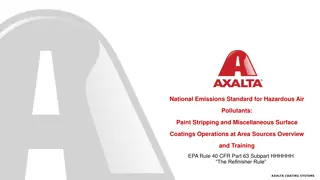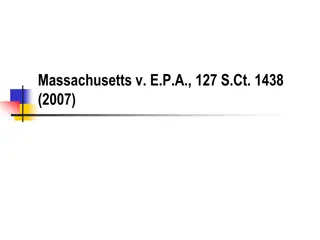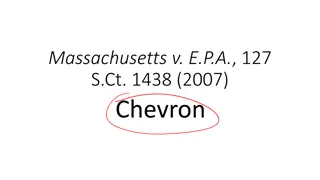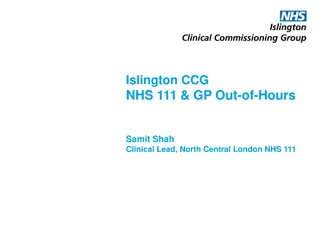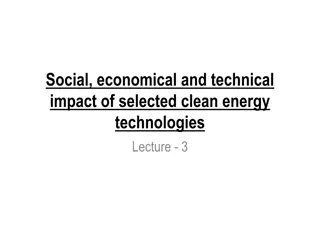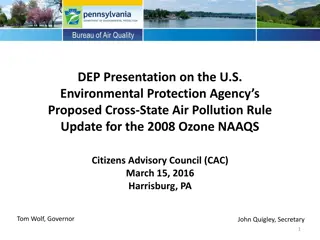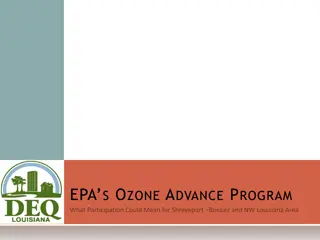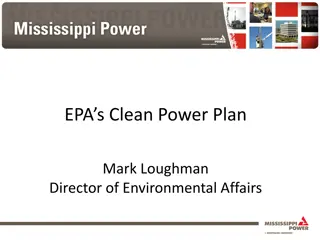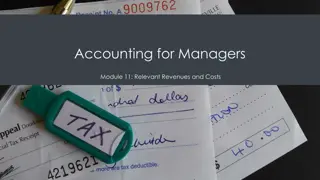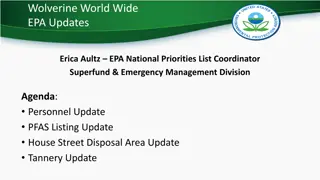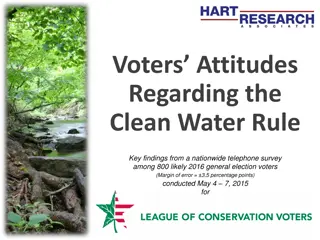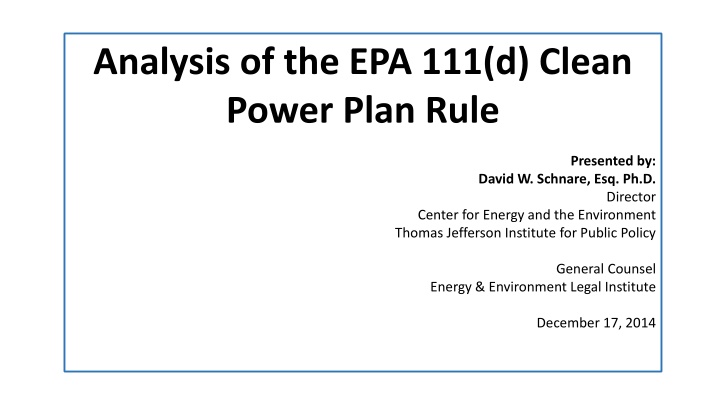
Analysis of EPA 111(d) Clean Power Plan Rule - Impacts, Costs, and Controversy
The analysis of the EPA 111(d) Clean Power Plan Rule by David W. Schnare highlights significant concerns, including adverse effects on low-income individuals, implications for public health, and potential economic costs. The rule's contentious nature is underscored by opposition from multiple states and entities. Issues such as projected premature deaths and limited environmental benefits are addressed, revealing a complex landscape of challenges and criticisms.
Uploaded on | 1 Views
Download Presentation

Please find below an Image/Link to download the presentation.
The content on the website is provided AS IS for your information and personal use only. It may not be sold, licensed, or shared on other websites without obtaining consent from the author. If you encounter any issues during the download, it is possible that the publisher has removed the file from their server.
You are allowed to download the files provided on this website for personal or commercial use, subject to the condition that they are used lawfully. All files are the property of their respective owners.
The content on the website is provided AS IS for your information and personal use only. It may not be sold, licensed, or shared on other websites without obtaining consent from the author.
E N D
Presentation Transcript
Analysis of the EPA 111(d) Clean Power Plan Rule Presented by: David W. Schnare, Esq. Ph.D. Director Center for Energy and the Environment Thomas Jefferson Institute for Public Policy General Counsel Energy & Environment Legal Institute December 17, 2014
Analysis of the EPA 111(d) Clean Power Plan The regulation will harm over 700,000 poor Virginians. It will cause more premature death than it will avoid. 25 Governors, 22 Attorneys General, 7 State Legislatures, 13 Public Utility Commissions, and 12 Environmental Departments argue the rule is illegal. A Virginia Energy Federalism Act would protect citizens, utilities and businesses through wait and see legislation without risk from EPA.
185,000 Families 537,000 Families
Health Impacts of Increased Energy Costs on Low Income Persons Percent of Low Income Persons 45% 40% 35% 30% 25% 20% 15% 10% 5% 0% Went Without Food Went Without Medical Care Did Not Fill Prescription Became Sick Source: NEADA 2008 National Energy Assistance Survey
The 111(d) Rule will cost lives EPA claims the rule will prevent up to 6,600 premature deaths. EPA failed to disclose the health-wealth impacts. The loss of $560 billion in disposable income citizens will pay to cut electricity use under the rule (only one of 4 pillars of the rule) will cause 47,700 premature deaths as calculated using EPA s own economic analysis methods.
The EPA Plan is All Pain and No Gain EPA s plan would reduce global temperatures by 0.02 deg. C. by 2100. EPA has admitted this fact. Expenditures on the plan will take tax revenue out of the state s budget and will force traditional environmental spending to compete with new work required under the federal Plan. Restated, traditional environmental protection will lose funding and attention under the plan. 111, 2014, http://www.cato.org/blog/002degc-temperature-rise-averted-vital-number-missing-epas-numbers-fact-sheet. Knappenberger, P.C. & Michaels, P.J. 0.02oC Temperature Rise Averted: The Vital Number Missing from the EPA s By the Numbers Fact Sheet, Cato Institute, June http://www.epw.senate.gov/public/index.cfm?FuseAction=Hearings.Choose&Hearing_id=8655edd9-03ac-bb36-cab8-7913ec6c2b94. Testimony before the Senate Committee on Environment and Public Works,
Why is the 111(d) Rule Illegal? EPA attempts to regulate outside the fence , an authority the Clean Air Act does not offer. Under the rule, Virginia loses its authority to decide what energy utilities may generate and/or use, and would force Virginia to establish a renewable energy standard. EPA requires Virginia to redispatch (shift) generation from coal-fired plants to natural gas-fired plants. Dispatch of generation is not within either Federal or State control. It is done by private balancing authorities under FERC guidance. Under 111(d) States are allowed freedom to craft any form of implementation plan it wishes as long as it achieves the pollution standard. EPA replaces this with a binding, inflexible approach. EPA may not use 111(d) if it has already regulated sources under Section 112, which it has done.
Who thinks the 111(d) rule is illegal? Public Utility Commissions Withdraw the rule and/or ultra vires Arizona Idaho Kansas Louisiana Mississippi Montana New Jersey New Mexico (re. RPS) North Carolina Ohio Tennessee Texas Virginia Overly restricts the PUC Costs too much or is not implementable Florida Virginia Georgia Kansas Mississippi Missouri New Mexico North Carolina Ohio Virginia Wyoming California Colorado Delaware Illinois Iowa Kansas Maine Maryland Minnesota New York Vermont North Carolina Ohio Tennessee Wyoming
Who thinks the 111(d) rule is illegal? Governors Ultra vires or costs too much Alabama, Alaska Arkansas, Florida, Georgia, Idaho Indiana Kentucky, Louisiana, Maryland, Mississippi, Missouri, New Jersey North Carolina North Dakota Oklahoma, Pennsylvania South Carolina, Tennessee, Texas, Utah Virginia (cost) West Virginia Wisconsin Wyoming
Who thinks the 111(d) rule is illegal? State Legislatures Ultra vires and/or abridges state sovereignty Georgia Kentucky Missouri Montana Nebraska Pennsylvania Utah Legislation, Resolutions, Bills limiting 111(d) implementation Alabama (Resolution) Arizona (Resolution) Florida (Resolution) Georgia (Resolution) Indiana (Resolution) Kansas (Enactment) Kentucky (Bill) Missouri (Bill) Nebraska (Resolution) Oklahoma (Resolution) Pennsylvania (Enactment) South Dakota (Resolution) Tennessee (Resolution) Virginia (study bill only) West Virginia (Enactment) Wyoming (Resolution)
Who thinks the 111(d) rule is illegal? Attorneys General Withdraw as ultra vires Alabama Alaska Arizona Arkansas Florida Georgia Indiana Kansas Kentucky Louisiana Michigan Montana New Jersey 111d is legal New York, California, Massachusetts, Connecticut, Delaware, Maine, Maryland, New Mexico, Oregon, Rhode Island, Vermont, Washington, District Of Columbia Nebraska North Dakota Ohio Oklahoma South Carolina South Dakota West Virginia Wisconsin Wyoming
Who thinks the 111(d) rule is illegal? State Environmental Departments Ultra vires or otherwise exceeds EPA s authority Arizona Idaho Kansas Louisiana New Jersey North Carolina Ohio Pennsylvania Tennessee Texas Virginia (in part) Wyoming Costs too much Limits State Flexibility Alaska Georgia Tennessee California Colorado Connecticut Delaware Georgia Maryland Massachusetts Minnesota New Hampshire New York Oregon Rhode Island Vermont Virginia Washington
U.S. Congress House Energy and Commerce Committee Report on EPA s 111(d) Proposed Rule December 16, 2014 There are fundamental legal questionsabout the EPA s authority to regulate in this area and, assuming such authority, the scope of that authority; EPA s plan would transform federal and state decision-making concerning the transmission and delivery of electric power in the United States; Many of the key assumptions in the EPA s proposed building blocks are unrealistic; The proposal would not be workable for many states; and The accelerated timeline for completing the rulemaking appears inadequate to respond fully to all substantive comments.
What must Virginia do? Cut power sector CO2 emissions by 43 percent from 2012 levels by 2030. Require existing fossil fuel units to achieve a carbon emission rate that is as much as 26% lower than the carbon emission rate that the EPA recently determined can be achieved by new units. Turn SCC powers over to DEQ or EPA Initiate a renewable energy mandate on state utilities Create new authority to replace the Federal FERC/NERC authorities. Control electricity use in private homes, businesses and industry (demand side management). Craft a plan and obtain all legislative changes within one year.
Both EPA and Virginia lack the authority to implement the CPP as proposed EPA Clean Power Plan Mandate What Virginia would have to do to implement an acceptable Plan Building Blocks - I - Emissions Control Technical Feasibility Existing Virginia Authority Babcock-Wilcox reports a maximum potential efficiency increase at existing coal-fired power plants of 1.5% The Virginia State Commerce Commission regulates public utilities and coops but does not regulate municipal generation.1 The Air Pollution Control Board and the Department of Environmental Quality regulates emissions.2 Virginia does not control dispatch of generation plants and arguably is federally preempted from doing so.6 To meet the EPA carbon tonnage reduction, Virginia would have to close several existing coal-fired plants well ahead of their useful lifespans. The Virginia legislature would have to authorize the utility commission to regulate municipalities and to do so may require a Constitutional amendment. Virginia would have to legislate new authorities to bring these private balancing authorities under their control; an act that would trample federal regulation under FERC and NERC, and which FERC & NERC have opposed. Increase plant efficiency by 6% Combined cycle plants were not designed for 70% utilization and would age rapidly. Winter gas is predominantly used for heating. Natural gas pipelines are subject to freezing and this has caused blackouts. A nuclear plant addition has been seeking permits since 2001 and is on hold. It will take an additional 5 years for final certification, thus failing to meet the 2020 deadline. Virginia has 10 MW of solar and 0 MW of wind today and would have to add 3,300 MW of wind or 4,100 MW of solar and 1,500 MW of back-up natural gas none of which is now proposed. Indiana hoped to achieve a 2% reduction through conservation under its voluntary program. It did not succeed. - II - Increase natural gas combined cycle plant use from 40% to 70% Generation Dispatch Virginia does not mandate renewable power, but instead has a voluntary incentive program with a goal of 12% of retail by 2020.3 Virginia has exclusive authority to determine the siting and construction of generation (other than hydroelectric generation).4 The legislature would have to mandate a renewable power portfolio. Virginia s renewables program is subject to expiration. The solar program expires in 2016. - III - Increase use of nuclear and renewable generation Wind, Solar, Nuclear Generation Virginia s demand side management program is experimental and is scheduled to end in 2014.5 The Virginia legislature would have to mandate a reduction in electricity use (demand side management), one requiring customers to participate. - IV - Demand Management Reduce actual electricity use by 1.5% 1 Va. Code 56-231 et seq., 56-235 et seq. & 56-585 et seq. 2Va. Code 10.1-1301 et seq. 3 Va. Code 56-585.2. 4 Federal Power Act 205 &206 (16 U.S.C. 824), and see, e.g., Californians for Renewable Energy Inc. v. California Independent System Operator Corp., 117 FERC 61,072 at P 10 (2006); PacifiCorp, 72 FERC 61,087 at 61,488 & n.3 (1995); Duke Power Co., 43 FERC 61,001 at 61,003 (1988): Northeast Maryland Waste Disposal Authority, 53 FERC 61,161 at 61,587 (1990), reh g denied, 54 FERC 61,058 (1991); Southern Company Services, Inc., 22 FERC 61,047 at 61,084 (1983).
Ancillary Problems Ancillary EPA Authorities Civil Penalties Clean Air Act Authority Additional necessary Indiana Legislative Action Sovereignty Issue Existing Indiana Authority Virginia utility law does not authorize the SCC to impose civil (or criminal) penalties greater than one-time $10,000 fines. Virginia environmental law allows for a $32,500 per violation civil penalty, capped at $100,000 per order.1 CAA criminal penalties are referred to the Attorney General and subject to unclassified felonies and misdemeanors. The maximum felony penalty is $100,000 and the maximum misdemeanor penalty is $2,500.2 Virginia has not entered a compact. To maintain enforcement parity with the Federal government, the Virginia legislature would have to authorize the SCC to incorporate federal penalty policy into its utility regulation structure. Authorizes $37,500 per day civil penalties for violation of emissions regulations. The CPP gives EPA greater enforcement power over rate setting, utility regulation and consumers than that authorized by the state The Virginia legislature would have to increase its penalties for SCC violations to class 4 felonies in order to get to $37,500 per day penalties and would have to increase penalties for Class 1 misdemeanors by more than ten times. Criminal Penalties Authorizes criminal enforcement including up to $37,500 per day penalties. Indiana has first priority as the enforcement agency under the Clean Air Act and Federal intervention in the face of a state action is extremely rare, even if permissible. Interstate Cap and Trade Consider multi-state compacts to allow inter-state carbon trading. Legislate all new authorities by 6/30/2016 Each state must have identical statutes. 2015 Senate bills must be filed by about 1/8; House bills by about 1/8 Virginia must craft its plan and obtain all legislative changes within one year. Federal Preemption If Virginia does not act, EPA could issue a Federal Implementation Plan but only for emissions controls. 1 VA. Code 10.1-1309(A)(vi). 2 Va. Code 18.2-10 & 11.
What has Virginia already done? From 2005 to 2012, CO2 emissions from Virginia power generation facilities declined by 40% due to increased use of nuclear power, heat rate improvements, coal unit retirements, new gas generation, and energy efficiency. Regardless of the EPA rule, Dominion has planned additional investments and retirements which are projected to decrease CO2 emissions by another 28%. SCC staff regard those recent and planned infrastructure improvements as reasonable and prudent. The rule does not allow Virginia to take credit for most of these emissions reductions.
States are free to wait and see. The legality of the rule is already before the Court. The question of legality will take 18 months to 2 years to resolve. The proposed rule has anticipatory effects that cannot be reversed and which involve significant costs. Future Majority Leader McConnell will do everything in his power to protect the states from EPA which is expected to take the form of a bar on EPA preparing Federal Implementation Plans if a state does not submit a plan States can decide to simply wait until the courts have settled the legal question before expending any resources to prepare a plan. They have already examined the rule and need do no more. Legislatures can pass wait and see legislation.
A State Energy Federalism Act Providing Reliable, Affordable, Safe Power (RASP) These have been called RASP Acts. Halt the expenditure of state funding of Plan development and implementation until the Courts have determined whether the rule is legal. Require the state legislature to approve any implementation plan. Require a report on the affordability and reliability of electricity under the plan before the legislature votes. Prevent any attempts to close a coal-fired plant if the plant is still needed to ensure reliability. Require the State Corporation Commission to make decisions based on least-cost methodology. Cap electricity rate increases for higher greenhouse gas regulations at 1.5%.
David W. Schnare, Esq. Ph.D. Director Center for Energy and the Environment Thomas Jefferson Institute for Public Policy General Counsel Energy & Environment Legal Institute Schnare@EELegal.org




